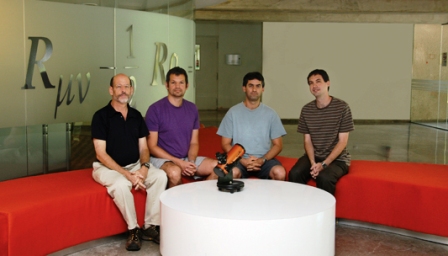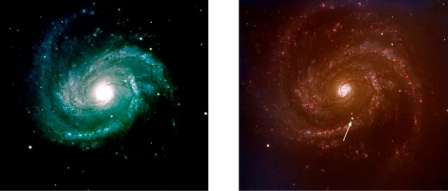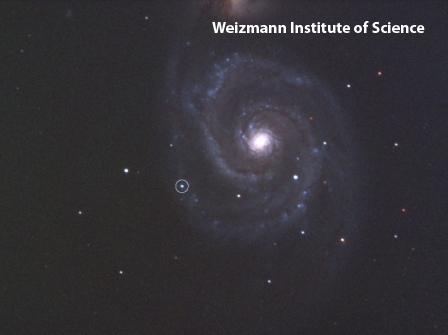Cosmic distances are difficult to grasp and no less difficult to measure. When it comes to other galaxies or even remote parts of our own Milky Way, distance measurements are nothing but assessments, derived from indirect clues.
Highly important among such clues are supernovae, extremely luminous stellar explosions. The distance to a supernova of a particular type, called Type Ia, can be calculated from its brightness: the brighter it appears, the closer it is to the viewer. Thanks to such supernovae, for example, astronomers have famously revealed that our universe is expanding at an accelerated pace, which suggests that it’s permeated with mysterious dark energy. These calculations, however, are based on the assumption that all Type Ia supernovae have the same luminosity. Are all these explosions indeed created equal?
Type Ia supernovae are thought to be born when an exceedingly dense star called a white dwarf receives more mass from a nearby star, until it’s so “overwhelmed” that it explodes.
A new study reported in Science and led by Weizmann Institute researchers, has gained major insight into the nature of these mass “donors.” The study was performed by
Dr. Avishay Gal-Yam and postdoctoral fellow Dr. Assaf Sternberg of Weizmann’s Particle Physics and Astrophysics Department, in collaboration with scientists from more than a dozen research centers in the United States, Europe and Australia.
The researchers have revealed that in about a quarter of the cases in spiral galaxies (like the one pictured above), and possibly more, the companion star that “donates” its mass to the white dwarf is probably a regular, medium-sized star, largely similar to our own Sun. They reached this conclusion by analyzing the outflow of gas, typical of sun-like stars, observed during the “donation” of the mass. These findings constitute a major step toward determining the nature of all stellar “donors,” with the ultimate goal of establishing whether supernovae everywhere evolve in the same manner, having the same luminosity at various stages. Understanding their evolution, in turn, can greatly enhance our ability to measure distances throughout the cosmos and map its evolution and geometry.
Institute observatory captures images of a new supernova
Exploding stars are the "factories" that produce all the heavy elements found, among other places, in our bodies. In this sense, we are all stardust. These exploding stars – supernovae – are highly energetic events that can occasionally light up the night sky. Such an explosion generally disrupts the balance between gravity – which pulls the star's material inward – and the thermonuclear reaction at the star's core – which heats it and pushes it outward.
Certain types of stars to which this happens have 10-100 time the mass and are much younger than our sun. In them, the nuclear reaction begins like that of our sun – fusing hydrogen into helium – but the fusion then continues, producing heavier and heavier elements. The nuclear reaction eventually stops with iron, as there is no energy benefit to the star to fuse the heavier atoms, and the balance between gravity and thermonuclear activity comes to a halt. Gravity then takes over, and the mass of the star collapses quickly, releasing so much energy in the process that the explosion ensues. The star hurls its outer layers into space, and a new "bright star" appears in the night sky where none was seen before. Just such a new star was observed in the night sky between May 31 and June 1 in a spiral arm of our galaxy's close neighbor, the M51 galaxy.
The first to identify the supernova were amateur astronomers in France, and soon after it was detected by the Palomar Transient Factory (PTF) Sky Survey, in which Weizmann Institute scientists participate (see below). The phenomenon was also photographed in the new Martin Kraar Observatory at the Weizmann Institute, as well as in Tel Aviv University's Wise Observatory in Mitzpe Ramon. Israel's place on the globe enables its scientists to follow supernova events when it is daytime for many other observers, and thus to add significantly to the data collection.
The new supernova is being studied by an international team of researchers, including Dr. Avishay Gal-Yam and his research team, Drs. Ofer Yaron, David Polishook and Dong Xu, research students Iair Arcavi and Sagi Ben Ami, and Director of the Kraar Observatory, Ilan Manulis, all of the Weizmann Institute's Particle Physics and Astrophysics Department, as well as scientists from the US, England, Canada and other countries. They have already noted that the material thrown into space in the explosion contains a wide variety of elements. The mix they observed is atypical of supernova events at such an early stage of the explosion, and they plan to investigate this phenomenon.
The last supernova observed in M51 (which is a mere 26 million light years away) occurred in 2005. Supernovae are thought to appear about once in 100 years in any given galaxy. The high occurrence in M51 can be explained by its interaction with a nearby galaxy, which causes the process of massive star formation to accelerate, thus increasing the rate of collapse and explosion as well.
Brighter, hotter, faster
A new class of supernova has scientists baffled. Recently, astrophysicists participating in the Palomar Transient Factory (PTF) – a project based at the Palomar Observatory in California that searches for transient flashes of light indicating stellar explosions –
identified four new supernovae that did not conform to any known patterns. The PTF is an international collaboration in which the Weizmann Institute is a founding partner. The Institute’s Dr. Avishay Gal-Yam and research student Iair Arcavi, and Dr. Eran Ofek of the California Institute of Technology, who will soon be joining the Weizmann Institute, were part of the team that identified what makes these exploding stars so unique. In the process, they realized that another two, discovered earlier, also fit the pattern, bringing the number of supernovae in the new class to six.
So far, they have found that these supernovae have very little hydrogen – a puzzle, since most stars throw out large amounts of hydrogen when they explode. In addition, they are about ten times brighter than the most common type of supernova, and hotter as well; they expand at a rate of about 10,000 kilometers a second; and they take much longer to fade away than the others.
The processes that shape these new supernovae can’t be explained by the existing models, though several explanations have been proposed. Strangely, all were found in dwarf galaxies, and the explosions lit up these dim galaxies, illuminating the hard-to-see star groups and possibly shedding light on the fate of ancient, massive stars in the early Universe.

Dr. Avishai Gal-Yam’s research is supported by the Nella and Leon Benoziyo Center for Astrophysics; the Yeda-Sela Center for Basic Research; the Peter and Patricia Gruber Award; the Legacy Heritage Fund Program of the Israel Science Foundation; Miel de Botton Aynsley, UK; and the Lord Sieff of Brimpton Memorial Fund.


